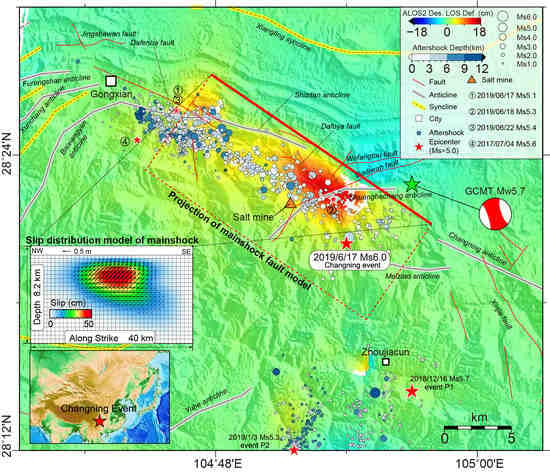Source Geometry and Causes of the 2019 Ms6.0 Changning Earthquake in Sichuan, China Based on InSAR
Abstract
:1. Introduction
2. Tectonic Setting
3. Data and Methods
3.1. D-InSAR Coseismic Deformation Processing
3.2. Fault Model Inversion
3.3. Coulomb Stress Change
3.4. The Maximum Induced Earthquake Magnitude
4. Results
4.1. Deformation Features
4.2. Fault Model
4.3. Coulomb Stress Change
4.4. The Maximum Induced Earthquake Magnitude
5. Discussion
5.1. Fault Model Analysis
5.2. Causes of the Changning Earthquake
5.2.1. Tectonic Analysis
5.2.2. Pre-Earthquake Effect
5.2.3. Effect of Hydraulic Fracturing and Water Loss
5.3. Aftershock Distribution
6. Conclusions
- The Changning earthquake caused a deformation area of about 150 km2 with a maximum of 17.2 cm (LOS) in the northwest of the epicenter.
- The Changning earthquake is a unidirectional rupture earthquake with left-lateral slip and thrust components. P1 is a pure left-lateral event, and P2 is dominated by thrust slip.
- There is no direct evidence to suggest that the Changning earthquake is related to hydraulic fracturing. We infer that the Changning earthquake may be advanced by salt mining, but P1 and P2 may also play an important role in advancing the Changning earthquake.
- The characteristics of aftershock distribution indicate that the seismic activities may be controlled by crust heterogeneity and structural complexity.
Supplementary Materials
Author Contributions
Funding
Data Availability Statement
Acknowledgments
Conflicts of Interest
References
- Yi, G.X.; Long, F.; Liang, M.J.; Zhao, M.; Wang, S.W.; Gong, Y.; Qiao, H.Z.; Su, J.R. Focal mechanism solutions and seisogenic structure of the 17 June 2019 Ms6.0 Sichuan Changning earthquake sequence. Chin. J. Geophys. 2019, 62, 3432–3447. [Google Scholar] [CrossRef]
- Jiang, D.; Zhang, S.; Ding, R. Surface deformation and tectonic background of the 2019 Ms 6.0 Changning earthquake, Sichuan Basin, SW China. J. Asian Earth Sci. 2020, 200, 104493. [Google Scholar] [CrossRef]
- Ruan, X.; Cheng, W.Z.; Zhang, Y.J.; Li, J.; Chen, Y. Research of the earthquakes induced by water injections in salt mines in Changning, Sichuan. Earthq. Res. China 2008, 24, 226–234. [Google Scholar]
- Sun, X.; Yang, P.; Zhang, Z. A study of earthquakes induced by water injection in the Changning salt mine area, SW China. J. Asian Earth Sci. 2017, 136, 102–109. [Google Scholar] [CrossRef]
- Lei, X.; Wang, Z.; Su, J. The December 2018 ML 5.7 and January 2019 ML 5.3 earthquakes in South Sichuan basin induced by shale gas hydraulic fracturing. Seismol. Res. Lett. 2019, 90, 1099–1110. [Google Scholar] [CrossRef]
- Lei, X.; Wang, Z.; Su, J. Possible link between long-term and short-term water injections and earthquakes in salt mine and shale gas site in Changning, south Sichuan Basin, China. Earth Planet. Phys. 2019, 3, 510–525. [Google Scholar] [CrossRef]
- The six unit of the first district survey team of the Sichuan Provincial Geological Bureau. The Geological Report of the Junlian Region. 1973. Available online: http://www.ngac.cn/125cms/c/qggnew/index.htm (accessed on 20 April 2022). (In Chinese).
- Ellsworth, W.L. Injection-induced earthquakes. Science 2013, 341, 1225942. [Google Scholar] [CrossRef]
- Sumy, D.F.; Cochran, E.S.; Keranen, K.M.; Wei, M.; Abers, G.A. Observations of static Coulomb stress triggering of the November 2011 M5. 7 Oklahoma earthquake sequence. J. Geophys. Res. Solid Earth 2014, 119, 1904–1923. [Google Scholar] [CrossRef]
- He, D.F.; Lu, R.Q.; Huang, H.Y.; Wang, X.S.; Jiang, H.; Zhang, W.K. Tectonic and geological setting of the earthquake hazards in the Changning shale gas development zone, Sichuan Basin, SW China. Pet. Explor. Dev. 2019, 46, 1051–1064. [Google Scholar] [CrossRef]
- Liu, J.; Zahradník, J. The 2019 MW 5.7 Changning Earthquake, Sichuan Basin, China: A Shallow Doublet with Different Faulting Styles. Geophys. Res. Lett. 2020, 47, e2019GL085408. [Google Scholar] [CrossRef] [Green Version]
- Wang, S.; Jiang, G.; Weingarten, M.; Niu, Y. InSAR evidence indicates a link between fluid injection for salt mining and the 2019 Changning (China) earthquake sequence. Geophys. Res. Lett. 2020, 47, e2020GL087603. [Google Scholar] [CrossRef]
- Li, T.; Sun, J.; Bao, Y.; Zhan, Y.; Shen, Z.K.; Xu, X.; Lasserre, C. The 2019 Mw 5.8 Changning, China earthquake: A cascade rupture of fold-accommodation faults induced by fluid injection. Tectonophysics 2021, 801, 228721. [Google Scholar] [CrossRef]
- McGarr, A.; Simpson, D.; Seeber, L.; Lee, W. Case histories of induced and triggered seismicity. Int. Geophys. Ser. 2002, 81, 647–664. Available online: https://earthquake.usgs.gov/static/lfs/research/induced/McGarr-Simpson-Seeber-2002-International-Geophysics.pdf (accessed on 20 April 2022).
- Gan, W.; Zhang, P.; Shen, Z.K.; Niu, Z.; Wang, M.; Wan, Y.; Zhou, D.; Cheng, J. Present-day crustal motion within the Tibetan Plateau inferred from GPS measurements. J. Geophys. Res. Solid Earth 2007, 112, B08416. [Google Scholar] [CrossRef] [Green Version]
- Sun, B. Characteristics of Structural Deformation and Fluid Activity in Changning Area and Its’ Perphery, Southern Sichuan. Master′s Thesis, Chengdu University of technology, Chengdu, China, 2018. Available online: https://kns.cnki.net/KCMS/detail/detail.aspx?dbname=CMFD201901&filename=1018259172.nh (accessed on 20 April 2022). (In Chinese).
- Feng, G.; Li, Z.; Xu, B.; Shan, X.; Zhang, L.; Zhu, J. Coseismic deformation of the 2015 M w 6.4 Pishan, China, earthquake estimated from Sentinel-1A and ALOS2 data. Seismol. Res. Lett. 2016, 87, 800–806. [Google Scholar] [CrossRef]
- Xu, B.; Li, Z.; Feng, G.; Zhang, Z.; Wang, Q.; Hu, J.; Chen, X. Continent-wide 2-D co-seismic deformation of the 2015 Mw 8.3 Illapel, Chile earthquake derived from Sentinel-1A data: Correction of azimuth co-registration error. Remote Sens. 2016, 8, 376. [Google Scholar] [CrossRef] [Green Version]
- Xu, W.B.; Feng, G.C.; Meng, L.S.; Zhang, A.L.; Ampuero, J.P.; Bürgmann, R.; Fang, L.H. Transpressional rupture cascade of the 2016 Mw 7.8 Kaikoura earthquake, New Zealand. J. Geophys. Res. Solid Earth 2018, 123, 2396–2409. [Google Scholar] [CrossRef]
- Wang, L.Y.; Gao, H.; Feng, G.C.; Xu, W.B. Source parameters and triggering links of the earthquake sequence in central Italy from 2009 to 2016 analyzed with GPS and InSAR data. Tectonophysics 2018, 744, 285–295. [Google Scholar] [CrossRef]
- Zhang, L.; Liao, M.S.; Balz, T.; Shi, X.G.; Jiang, Y.N. Monitoring landslide activities in the three gorges area with multi-frequency satellite SAR data sets. In Modern Technologies for Landslide Monitoring and Prediction; Springer: Berlin/Heidelberg, Germany, 2015; pp. 181–208. [Google Scholar]
- Liao, M.S.; Zhang, L.; Shi, X.G.; Jiang, Y.N.; Dong, J.; Liu, Y.Z. Method and Practice of Landslide Deformation Monitoring by Radar Remote Sensing; Science Press: Beijing, China, 2017. [Google Scholar]
- Gao, H.; Liao, M.S.; Liang, X.; Feng, G.C.; Wang, G.H. Co-seismic and post-seismic fault kinematics of the 22 July 2020, Nima (Tibet) Ms6. 6 earthquake: Implications of the forming mechanism of the active N-S-trending grabens in Qiangtang, Tibet. Tectonics 2022, 41, e2021TC006949. [Google Scholar] [CrossRef]
- Wegmuller, U.; Werner, C. Retrieval of vegetation parameters with SAR interferometry. IEEE Trans. Geosci. Remote Sens. 1997, 35, 18–24. [Google Scholar] [CrossRef]
- Farr, T.G.; Rosen, P.A.; Caro, E.; Crippen, R.; Duren, R.; Hensley, S.; Kobrick, M.; Paller, M.; Rodriguez, E.; Roth, L.; et al. The shuttle radar topography mission. Rev. Geophys. 2007, 45, RG2004. [Google Scholar] [CrossRef] [Green Version]
- Costantini, M. A novel phase unwrapping method based on network programming. IEEE Trans. Geosci. Remote Sens. 1998, 36, 813–821. [Google Scholar] [CrossRef]
- Jónsson, S.; Zebker, H.; Segall, P.; Amelung, F. Fault slip distribution of the 1999 Mw 7.1 Hector Mine, California, earthquake, estimated from satellite radar and GPS measurements. Bull. Seismol. Soc. Am. 2002, 92, 1377–1389. [Google Scholar] [CrossRef]
- Gao, H.; Liao, M.; Feng, G. An Improved Quadtree Sampling Method for InSAR Seismic Deformation Inversion. Remote Sens. 2021, 13, 1678. [Google Scholar] [CrossRef]
- Okada, Y. Surface deformation due to shear and tensile faults in a half-space. Bull. Seismol. Soc. Am. 1985, 75, 1135–1154. [Google Scholar] [CrossRef]
- Okada, Y. Internal deformation due to shear and tensile faults in a half-space. Bull. Seismol. Soc. Am. 1992, 82, 1018–1040. [Google Scholar] [CrossRef]
- Eberhart, R.; Kennedy, J. Particle swarm optimization. Proc. IEEE Int. Conf. Neural Netw. 1995, 4, 1942–1948. Available online: http://citeseerx.ist.psu.edu/viewdoc/download?doi=10.1.1.931.1264&rep=rep1&type=pdf (accessed on 20 April 2022).
- Paatero, P.; Tapper, U. Positive matrix factorization: A non-negative factor model with optimal utilization of error estimates of data values. Environmetrics 1994, 5, 111–126. [Google Scholar] [CrossRef]
- Li, X.; Wang, C.; Zhu, C.; Wang, S.; Li, W.; Wang, L.; Zhu, W. Coseismic Deformation Field Extraction and Fault Slip Inversion of the 2021 Yangbi MW 6.1 Earthquake, Yunnan Province, Based on Time-Series InSAR. Remote Sens. 2022, 14, 1017. [Google Scholar] [CrossRef]
- Metropolis, N.; Ulam, S. The monte carlo method. J. Am. Stat. Assoc. 1949, 44, 335–341. [Google Scholar] [CrossRef]
- Lin, J.; Stein, R.S. Stress triggering in thrust and subduction earthquakes and stress interaction between the southern San Andreas and nearby thrust and strike-slip faults. J. Geophys. Res. Solid Earth 2004, 109, B02303. [Google Scholar] [CrossRef] [Green Version]
- Toda, S.; Stein, R.S.; Richards-Dinger, K.; Bozkurt, S.B. Forecasting the evolution of seismicity in southern California: Animations built on earthquake stress transfer. J. Geophys. Res. Solid Earth 2005, 110, B05S16. [Google Scholar] [CrossRef]
- McGarr, A. Maximum magnitude earthquakes induced by fluid injection. J. Geophys. Res. Solid Earth 2014, 119, 1008–1019. [Google Scholar] [CrossRef]
- Zhang, B.; Lei, J.; Zhang, G. Seismic evidence for influences of deep fluids on the 2019 Changning Ms 6.0 earthquake, Sichuan basin, SW China. J. Asian Earth Sci. 2020, 200, 104492. [Google Scholar] [CrossRef]
- Yang, Y.H.; Hu, J.C.; Chen, Q.; Lei, X.; Zhao, J.; Li, W.; Xu, R.; Chiu, C.-Y. Shallow slip of blind fault associated with the 2019 M S 6.0 Changning earthquake in fold-and-thrust belt in salt mines of Southeast Sichuan, China. Geophys. J. Int. 2021, 224, 909–922. [Google Scholar] [CrossRef]
- Lockner, D.A.; Beeler, N.M. Premonitory slip and tidal triggering of earthquakes. J. Geophys. Res. Solid Earth 1999, 104, 20133–20151. [Google Scholar] [CrossRef]
- Qian, H.; Tang, R.C. Seismo-geological features of the Sichuan Basin. Earthq. Res. Sichuan 1992, 3, 13–18. [Google Scholar]
- Bao, X.; Eaton, D.W. Fault activation by hydraulic fracturing in western Canada. Science 2016, 354, 1406–1409. [Google Scholar] [CrossRef]
- Schultz, R.; Atkinson, G.; Eaton, D.W.; Gu, Y.J.; Kao, H. Hydraulic fracturing volume is associated with induced earthquake productivity in the Duvernay play. Science 2018, 359, 304–308. [Google Scholar] [CrossRef] [Green Version]
- Segall, P. Stress and subsidence resulting from subsurface fluid withdrawal in the epicentral region of the 1983 Coalinga earthquake. J. Geophys. Res. Solid Earth 1985, 90, 6801–6816. [Google Scholar] [CrossRef]
- McGarr, A. On a possible connection between three major earthquakes in California and oil production. Bull. Seismol. Soc. Am. 1991, 81, 948–970. [Google Scholar]
- Wilson, M.P.; Foulger, G.R.; Gluyas, J.G.; Davies, R.J.; Julian, B.R. HiQuake: The human-induced earthquake database. Seismol. Res. Lett. 2017, 88, 1560–1565. [Google Scholar] [CrossRef] [Green Version]
- Ellsworth, W.L.; Giardini, D.; Townend, J.; Ge, S.M.; Shimamoto, T. Triggering of the Pohang, Korea, Earthquake (Mw 5.5) by Enhanced Geothermal System Stimulation. Seismol. Res. Lett. 2019, 90, 1844–1858. [Google Scholar] [CrossRef]
- Grigoli, F.; Cesca, S.; Rinaldi, A.P.; Manconi, A.; Lopez-Comino, J.A.; Clinton, J.F.; Westaway, R.; Cauzzi, C.; Dahm, T.; Wiemer, S. The November 2017 Mw 5.5 Pohang earthquake: A possible case of induced seismicity in South Korea. Science 2018, 360, 1003–1006. [Google Scholar] [CrossRef] [Green Version]
- Kim, K.H.; Ree, J.H.; Kim, Y.; Kim, S.; Kang, S.Y.; Seo, W. Assessing whether the 2017 Mw 5.4 Pohang earthquake in South Korea was an induced event. Science 2018, 360, 1007–1009. [Google Scholar] [CrossRef] [Green Version]
- Proctor, B.; Lockner, D.A.; Kilgore, B.D.; Mitchell, T.M.; Beeler, N.M. Direct evidence for fluid pressure, dilatancy, and compaction affecting slip in isolated faults. Geophys. Res. Lett. 2020, 47, e2019GL086767. [Google Scholar] [CrossRef]
- Utsu, T. A statistical study on the occurrence of aftershocks. Geophys. Mag. 1961, 30, 521–605. [Google Scholar]
- Stein, R.S.; King, G.C.; Lin, J. Change in failure stress on the southern San Andreas fault system caused by the 1992 magnitude= 7.4 Landers earthquake. Science 1992, 258, 1328–1332. [Google Scholar] [CrossRef]
- Huang, H.; Xu, W.; Meng, L.; Bürgmann, R.; Baez, J.C. Early aftershocks and afterslip surrounding the 2015 Mw 8.4 Illapel rupture. Earth Planet. Sci. Lett. 2017, 457, 282–291. [Google Scholar] [CrossRef] [Green Version]
- Liu, X.G.; Xu, W.B. Logarithmic Model Joint Inversion Method for Coseismic and Postseismic Slip: Application to the 2017 Mw 7.3 Sarpol Zahāb Earthquake, Iran. J. Geophys. Res. Solid Earth 2019, 124, 12034–12052. [Google Scholar] [CrossRef] [Green Version]
- Li, W.; Ni, S.; Zang, C.; Chu, R. Rupture Directivity of the 2019 M w 5.8 Changning, Sichuan, China, Earthquake and Implication for Induced Seismicity. Bull. Seismol. Soc. Am. 2020, 110, 2138–2153. [Google Scholar] [CrossRef]
- Métois, M.; Vigny, C.; Socquet, A.; Delorme, A.; Morvan, S.; Ortega, I.; Valderas-Bermejo, C.-M. GPS-derived interseismic coupling on the subduction and seismic hazards in the Atacama region, Chile. Geophys. J. Int. 2014, 196, 644–655. [Google Scholar] [CrossRef] [Green Version]
- Zhang, Z.W.; Long, F.; Wang, S.Y.; Gong, Y.; Wu, P.; Wang, H.; Jiang, G.M. Earthquake location and velocity structure in Yibin area, Sichuan. Seismol. Geol. 2019, 41, 913–926. [Google Scholar]
- Howarth, J.D.; Barth, N.C.; Fitzsimons, S.J.; Richards-Dinger, K.; Clark, K.J.; Biasi, G.P.; Cochran, U.A.; Langridge, R.M.; Berryman, K.R.; Sutherland, R. Spatiotemporal clustering of great earthquakes on a transform fault controlled by geometry. Nat. Geosci. 2021, 14, 314–320. [Google Scholar] [CrossRef]
- Sathiakumar, S.; Barbot, S. The stop-start control of seismicity by fault bends along the Main Himalayan Thrust. Commun. Earth Environ. 2021, 2, 87. [Google Scholar] [CrossRef]
- Kato, A.; Obara, K. Step-like migration of early aftershocks following the 2007 Mw 6.7 Noto-Hanto earthquake, Japan. Geophys. Res. Lett. 2014, 41, 3864–3869. [Google Scholar] [CrossRef]
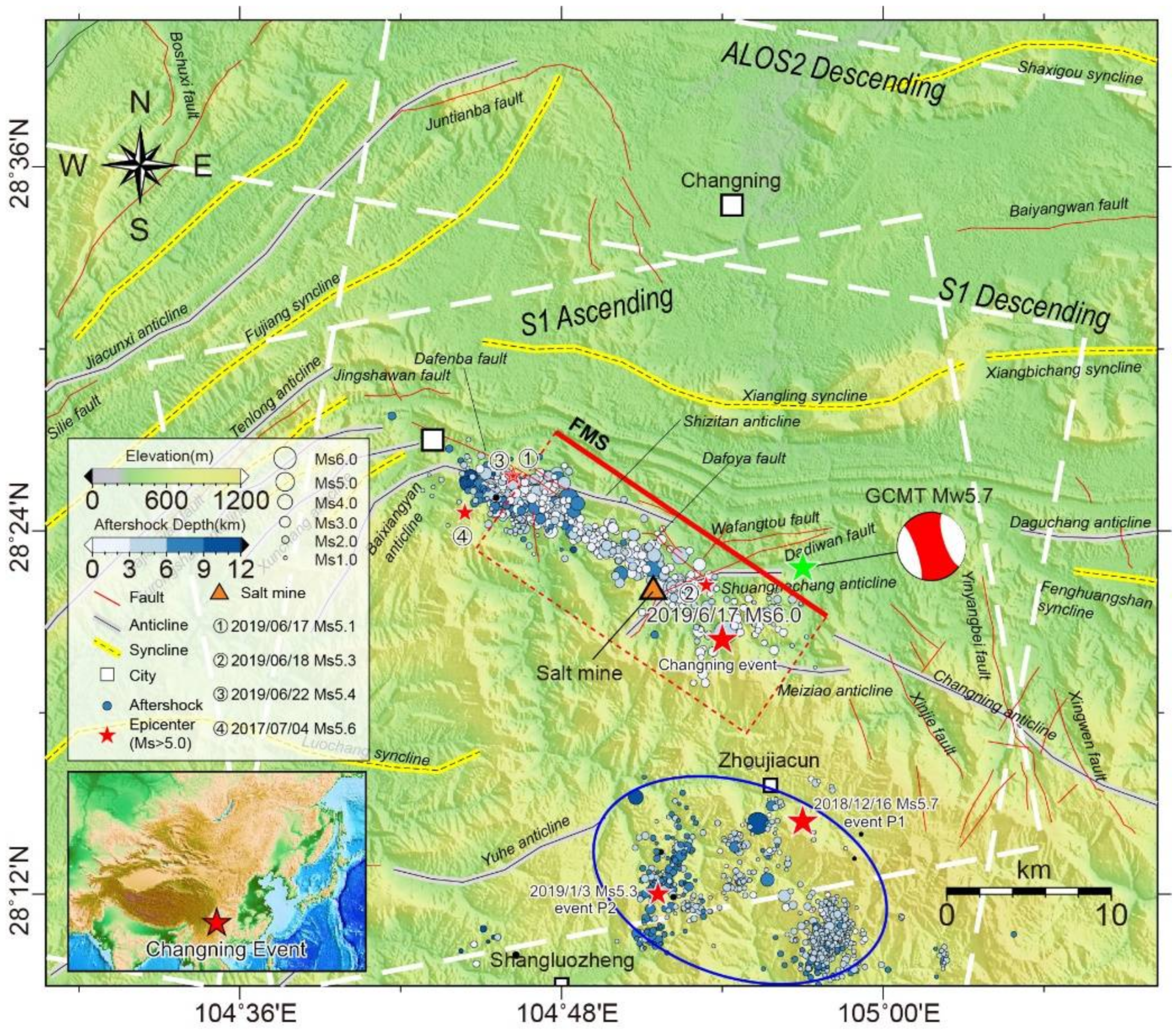
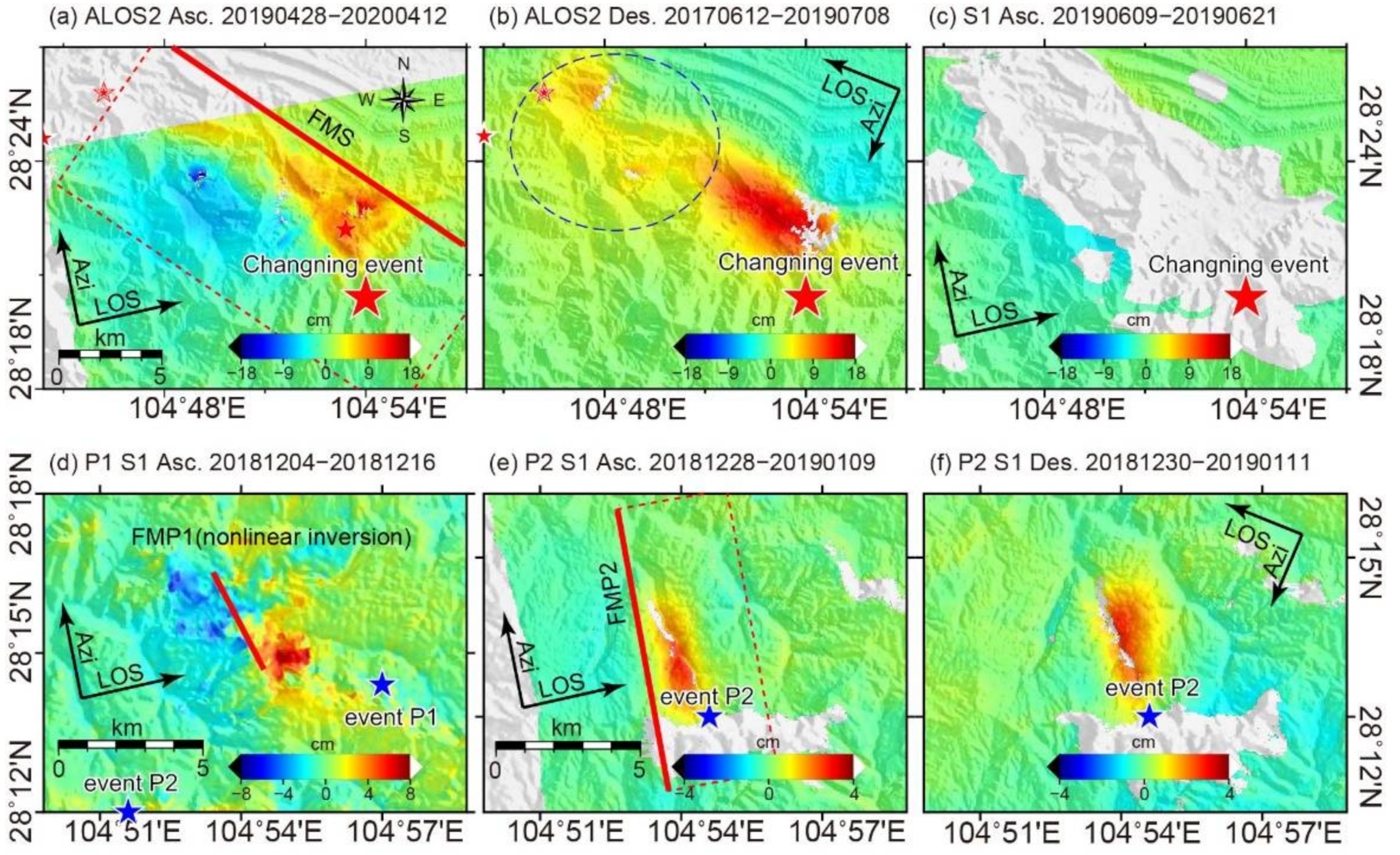
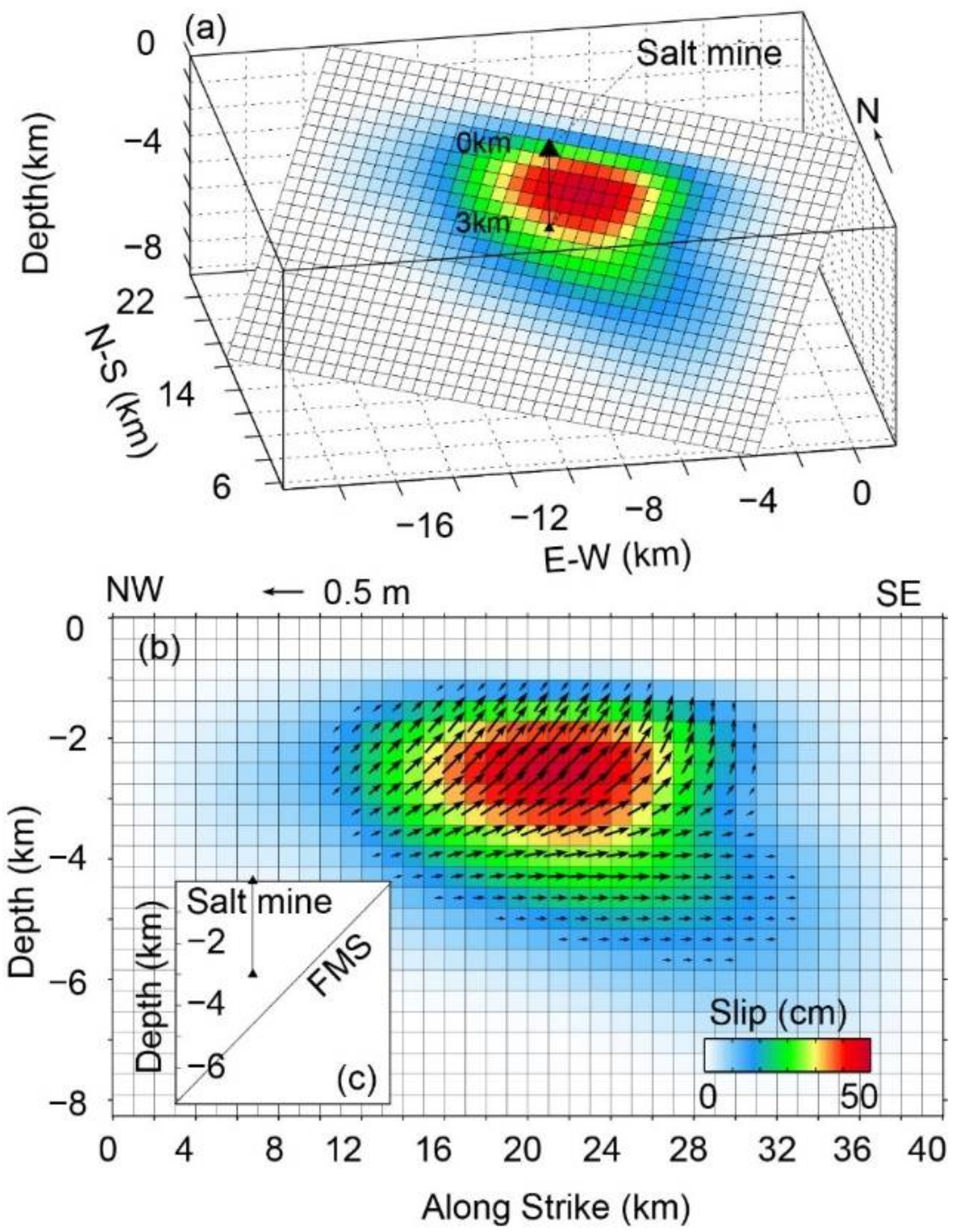
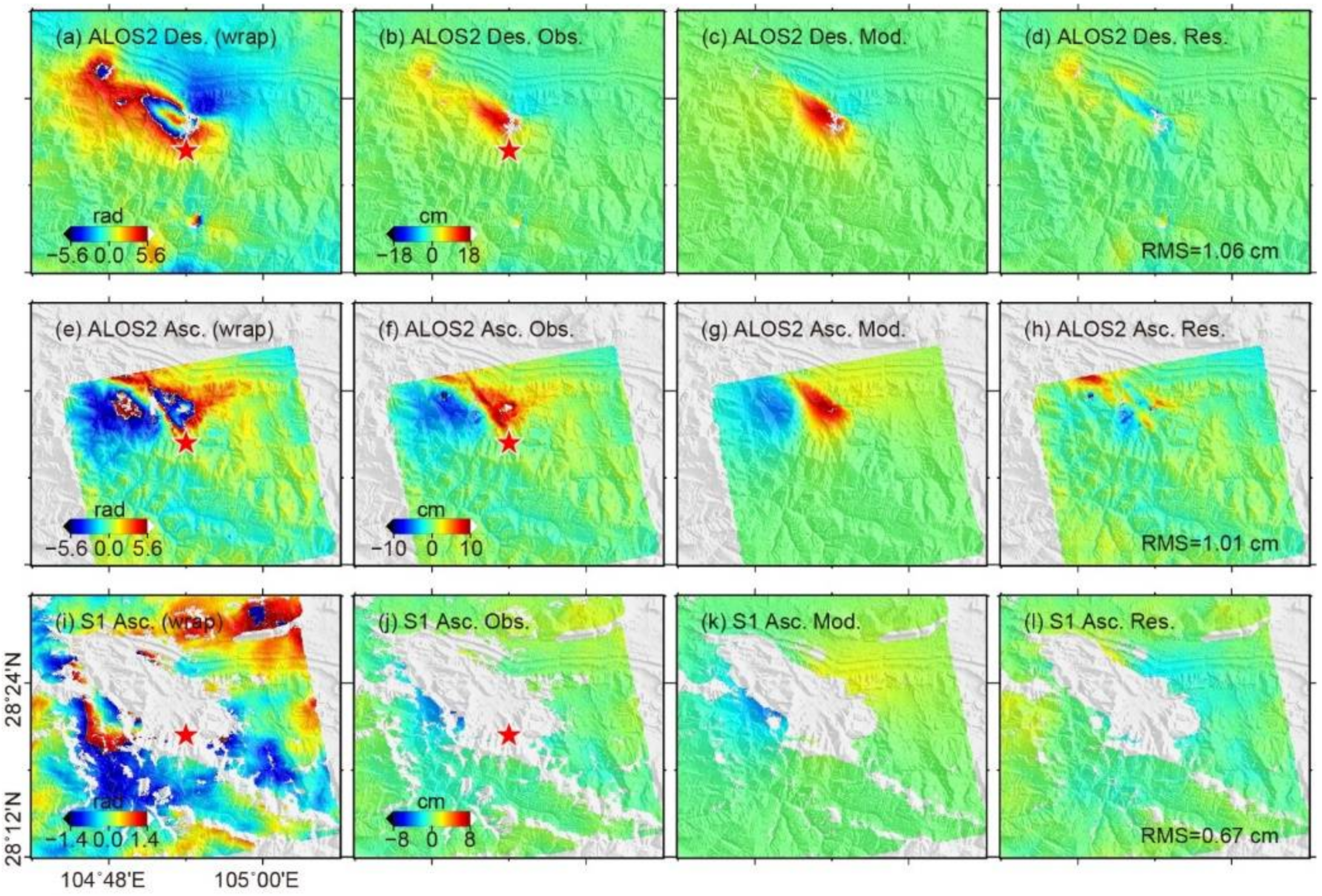

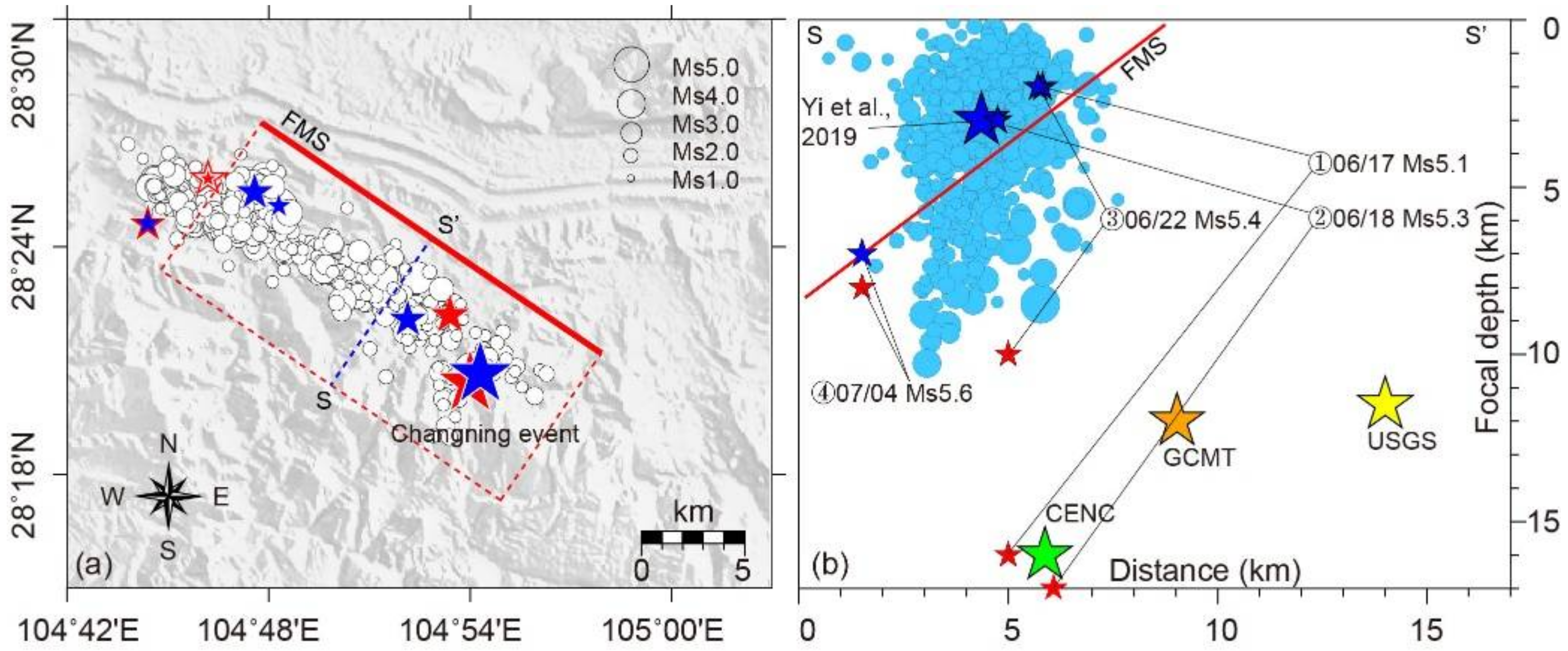
| Event | Date Day-Month-Year | Satellite | Orbit | Primary Day-Month-Year | Secondary Day-Month-Year | Perpendicular Baseline (m) | Pass |
|---|---|---|---|---|---|---|---|
| P1 | 16-Dec-18 | Sentinel-1 | Asc | 4-Dec-18 | 16-Dec-18 | 15 | 55 |
| P2 | 3-Jan-19 | Sentinel-1 | Asc | 28-Dec-18 | 9-Jan-19 | 123 | 55 |
| Sentinel-1 | Des | 30-Dec-18 | 11-Jan-19 | 9 | 164 | ||
| Changning | 17-Jun-19 | Sentinel-1 | Asc | 9-Jun-19 | 21-Jun-19 | 29 | 55 |
| ALOS2 | Asc | 28-Apr-19 | 12-Apr-20 | 40 | 146 | ||
| ALOS2 | Des | 12-Jun-17 | 8-Jul-19 | 69 | 37 | ||
| Aftershock ➂ | 22-Jun-19 | Sentinel-1 | Asc | 21-Jun-19 | 3-Jul-19 | 21 | 55 |
| Aftershock ➃ | 4-Jul-19 | Sentinel-1 | Asc | 3-Jul-19 | 15-Jul-19 | 28 | 55 |
| Event | Source | Lon./° | Lat./° | Depth/km | Strike/° | Dip/° | Rake/° | Mw | Note |
|---|---|---|---|---|---|---|---|---|---|
| Changning | This study (a) | 104.855 | 28.372 | 4.1 * | 124 | 43 | 40 | 5.65 | / |
| Yi et al. [1] | 104.905 | 28.344 | 3 ** | 131 | 51 | 36 | 5.79 | Plane 1 | |
| Wang et al. [12] | / | / | 1 * | 121 | 31 | / | 5.69 | Uniform slip model | |
| CENC (b) | 104.900 | 28.340 | 16 ** | / | / | / | / | / | |
| USGS (c) | 104.933 | 28.406 | 11.5 ** | 314 | 65 | 62 | 5.81 | Plane 1 | |
| GCMT (d) | 104.950 | 28.380 | 12 * | 117 | 87 | −2 | 5.7 | Plane 1 | |
| P1 | This study (e) | 104.901 | 28.258 | 1.7 * | 333 | 89 | −1 | 5.15 | / |
| Yi et al. [1] | 104.948 | 28.219 | 3 ** | 349 | 76 | −5 | 5.17 | Plane 2 | |
| CENC | 104.950 | 28.240 | 12 ** | / | / | / | / | / | |
| USGS | 105.013 | 28.295 | 17.5 ** | 349 | 83 | −3 | 5.28 | Plane 2 | |
| GCMT | 105.090 | 28.200 | 14 * | 348 | 84 | −9 | 5.3 | Plane 2 | |
| P2 | This study (f) | 104.856 | 28.224 | 2.3 * | 349 | 50 | 87 | 4.81 | / |
| Yi et al. [1] | 104.861 | 28.192 | 2 ** | 351 | 46 | 46 | 4.81 | Plane 2 | |
| CENC | 104.860 | 28.200 | 15 * | / | / | / | / | / | |
| USGS | 104.918 | 28.190 | 11.5 * | 355 | 48 | 59 | 4.85 | Plane 2 | |
| GCMT | 104.950 | 28.210 | 12 ** | 349 | 41 | 43 | 5 | Plane 1 |
Publisher’s Note: MDPI stays neutral with regard to jurisdictional claims in published maps and institutional affiliations. |
© 2022 by the authors. Licensee MDPI, Basel, Switzerland. This article is an open access article distributed under the terms and conditions of the Creative Commons Attribution (CC BY) license (https://creativecommons.org/licenses/by/4.0/).
Share and Cite
Gao, H.; Liao, M.; Liu, X.; Xu, W.; Fang, N. Source Geometry and Causes of the 2019 Ms6.0 Changning Earthquake in Sichuan, China Based on InSAR. Remote Sens. 2022, 14, 2082. https://doi.org/10.3390/rs14092082
Gao H, Liao M, Liu X, Xu W, Fang N. Source Geometry and Causes of the 2019 Ms6.0 Changning Earthquake in Sichuan, China Based on InSAR. Remote Sensing. 2022; 14(9):2082. https://doi.org/10.3390/rs14092082
Chicago/Turabian StyleGao, Hua, Mingsheng Liao, Xiaoge Liu, Wenbin Xu, and Nan Fang. 2022. "Source Geometry and Causes of the 2019 Ms6.0 Changning Earthquake in Sichuan, China Based on InSAR" Remote Sensing 14, no. 9: 2082. https://doi.org/10.3390/rs14092082
APA StyleGao, H., Liao, M., Liu, X., Xu, W., & Fang, N. (2022). Source Geometry and Causes of the 2019 Ms6.0 Changning Earthquake in Sichuan, China Based on InSAR. Remote Sensing, 14(9), 2082. https://doi.org/10.3390/rs14092082







